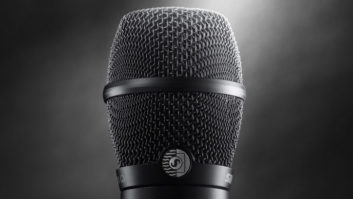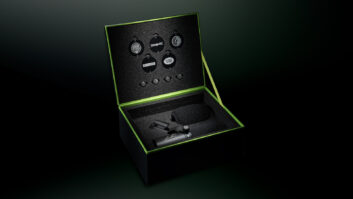
Shure’s PG Alta Series of microphones was designed to bring pro-quality sound down to reasonable price points. The Alta line comprises a variety of vocal and instrument microphones, the PGA181 being one of the more recent introductions. A side-address, cardioid condenser microphone, the PGA181 ($99) was designed for use on acoustic instruments and vocals, as well as amplified instruments. Shure sent Mix a pair of PGA181s so we could put them through their paces.
Basic and Black
The PGA181 is a very unassuming microphone: all black with a lollipop-type head mounted atop a sturdy, cast-zinc conical body. Construction feels solid and inspires confidence. Included with the mic are a stand holder, a soft carry case and an instruction booklet. The stand holder was cleverly designed with soft plastic ribs on the interior to prevent the mic from slipping—a smart move on the part of Shure’s engineers as the PGA181 weighs in at 13.5 ounces. The PGA181’s element is an electret condenser requiring 48-volt phantom power. Frequency response is specified as 50 to 20,000 Hz (±5 dB), and the capsule is rated to handle SPLs up to 138 dB.
Setting up the PGA181 was about as easy as you can get, but I’ll get my one gripe out of the way now: Because the PGA181 is side-address, its front is indicated with a cardioid graphic that is nearly impossible to see under normal lighting. I found it easier to remember that the side of the grille with the screws was the front.
I used the PGA181s live and in the studio for a wide variety of instruments and vocals. To get a feel for the sonic signature of the PGA181s, I started by connecting them to a Grace 201 preamplifier, a preamp that I know well for its transparency and extended frequency response at both ends of the spectrum. I placed the PGA181s in a spaced pair roughly four feet apart, six feet high over a drum kit. The recording was very natural and well balanced with a faithful sense of the room sound. Cymbals were clear without being splashy or spitty and, although the PGA181s were not super-extended on the bottom, kick and toms were well represented. When I tried a similar arrangement live, I was pleasantly surprised at the pattern control of the PGA181. In spite of the fact that there was quite a bit happening on stage (two guitars, bass, keys and vocals), the microphones picked up a minimal amount of bleed from the other instruments.
Versatile Operator
While auditioning the PGA181s on drums, I also tried them close-up on the kick, snare and toms. The microphone easily handled the SPL when placed in front of a kick drum, but the resultant sound was a bit on the rubbery side. As an “out” kick mic, the PGA181 fared a bit better, reducing the rubbery-ness of the close position and delivering more smack in the upper midrange—but let’s say that kick is not a great strength of this mic, nor was it meant to be. When used close-up on toms, the PGA181s absolutely slammed. Rack and floor toms had just the right amount of attack from stick on the head to give them presence, plus a fat, round bottom end and a really nice “doooom” on the decay. Close-up on a snare drum, the PGA181 avoided the usual splashy condenser mic leakage from the hi-hat, behaving more like a dynamic mic and sounding a hair thinner than, say, a Shure SM57 or Audix i5.
Next it was time to try the PGA181 on a solo violin, this time plugged into an Avalon AD2022 preamp. I placed the PGA181 about 18 inches over the violinist’s shoulder (roughly 5.5 feet high) pointing down toward the body of the instrument and slightly off-axis. The overall tone was very natural, though there was a hint of “boxy-ness” to the body of the violin and a bit more bow “scrape” than I’d care to hear. A few dB of EQ (cut) centered at 5 kHz made this disappear.
Used on a session for electric guitar, the PGA181 excelled. The guitarist was playing a Fender Strat through an old Acoustic G120 solid-state guitar amplifier. I placed the PGA181 four inches from the grille, halfway between the dust cap and the edge of one of the 12-inch speakers, about 30 degrees off-axis. The guitar player set the amp for just a bit of crunch when he played louder passages, which the PGA181 translated very well without harshness. Low notes were round and full without sounding sloppy, and on a few sections when he played a slide, the recording sounded beautiful. I’m not a big fan of condenser mics on guitar amps, but this was a welcome exception.
I then tried the PGA181 on a Taylor acoustic guitar with the same Avalon AD2022 mic preamp (see the “Try This” sidebar for details on microphone placement). The AD2022 has a switch that changes the input impedance between several values as a means of matching impedance to the microphone, and also as a way to color the response. Tonal differences between the impedance settings were subtle, but I felt that the PGA181 sounded best for acoustic guitar on the “Mic” setting. Signal level differences were more pronounced, with the PGA181’s level varying roughly 6 to 8 dB across the range of input impedance settings—the lowest output level resulting when the AD2022 was set to 50 ohms, and the highest output when set to “Mic.” This is typical of what happens when the input impedance is changed.
Because the timbre of the mic remained fairly consistent regardless of preamp impedance, I think it’s safe to say that the PGA181’s character will remain consistent when used with a variety of mic preamps. When the guitar was fingerpicked very softly, the PGA181 delivered crystal clear reproduction of fingernails on strings, though it lacked that sense of “air” produced by more expensive condenser microphones. I’ve noticed that the self-noise of some condenser microphones becomes apparent when recording quiet guitar tracks, but not so with the PGA181. Its self-noise was never evident. One thing to be aware of when considering the PGA181 is that your mic preamp needs to have a highpass filter because the microphone can transmit mechanical noise from a mic stand or even through movement of the cable.
Recording male lead vocals on a rock song with the Shure PGA181 proved interesting. It might not be the most flattering microphone for male vocals, especially when used at a distance of more than a foot. Proximity effect is subtle and “blooms” when the singer moved to within about 4 inches of the mic, but even at that distance the proximity effect is not overbearing. The singer didn’t love the way his voice sounded (how unusual). He felt that there was a bit of a peak in the midrange that made him sound nasal-y, but I felt that same characteristic helped his lead vocal track easily sit in front of a very busy mix. It also helped the vocal track stand up to some fairly aggressive compression that was added during both the tracking and mixing processes.
All-Around Great Value
One of the questions I hear most frequently from my audio students is: “I’m on a tight budget, and I need a pair of condenser microphones. What should I buy?” Given the general sound quality level (or lack thereof) exhibited by most inexpensive condenser mics, my response is often, “Don’t waste your money buying something that’s going in the garbage in a few years. Save up for a good pair.” Now I have a more realistic answer for them: “Get a pair of Shure PGA181s. You won’t regret it.” The PGA181 is an excellent all-around microphone that is so reasonably priced, it’s a no-brainer.
Try This
The Shure PGA181 makes an excellent microphone for recording acoustic guitar. Start with the microphone placed approximately one foot to 18 inches from the body of the guitar, directly facing where the neck meets the body. If the guitar sounds thin and requires more body, aim the microphone slightly toward the sound hole; if it requires less low end, aim the mic more toward the fretboard. Some large body acoustic guitars may produce excessive low end when close-miked. If that is the case, then moving the PGA181 back to a distance of 24 to 30 inches can help reduce proximity effect, and tighten up the bottom.







